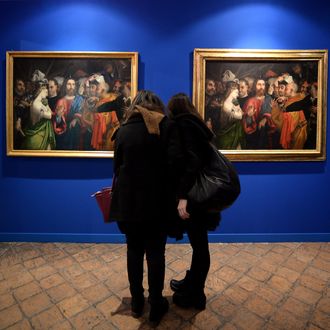
There’s something particularly special about viewing a piece of art in a museum setting. Or it feels that way, at least, when you imagine seeing a painting in person versus viewing a replica in postcard or desktop-background form. A new study in Acta Psychologia tried to better understand the reasons for this by asking a bunch of students to view either the museum or replica versions of art, then asking the students about their experiences.
As Christian Jarrett explains in the British Psychological Society’s Research Digest, a team led by David Brieber of the University of Wien split 137 psychology students up into three groups. One group first went “to view 25 artworks from Vienna’s Museum Startgalerie Beauty Contest exhibition — a series of paintings, photos and collages that explore self-image, sexuality and beauty,” as Jarrett put it, and then, a week later, viewed the same art and information plaques on a computer screen. A second group flipped the sequence — screens, then museum — while a third group viewed the exhibit virtually on both occasions.
Jarrett writes that “The students’ ratings after each experience showed that they found the actual art work at the museum more stimulating, positive, and interesting, and they liked it more, compared with the digital reproductions.” Moreover, the in-person exhibits were remembered more accurately, and this “seemed to come from the way the students used the physical layout of the exhibition as a mnemonic aid. When they successfully recalled one exhibit, they also tended to remember other pieces nearby.”
So if art is art, why was the museum version more enjoyable? The possible explanation is pretty interesting:
Taken together, the findings are consistent with theories of situated cognition: “inherently, a mind exists in context,” as Lisa Barrett and her colleagues once wrote. It seems there’s something about the physical space of a museum exhibition that changes how our minds respond to what we’re seeing. This contradicts formalist art theory, the idea that the effects of art upon us are independent of time and place.
There are signs that this is true not just when it comes to art, but with things like food and drink as well — past research has shown that all sorts of cues affect our perceptions of taste (wine is the most famous example — there’s a great deal of research showing “objective” ratings of how its taste can be affected by cues such as its cost).
So whether you’re paying a premium for wine at a fancy restaurant or shelling out a museum admission fee, you’re not just paying for the thing itself, but also for the experience that makes the thing more pleasurable — and memorable.




